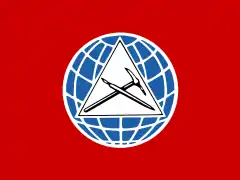People's Liberation Army (Lebanon)
The People's Liberation Army – PLA (Arabic: جيش التحرير الشعبي | Jayish al-Tahrir al-Sha'aby) or Armée de Libération Populaire (ALP) in French was the military wing of the left-wing Druze Progressive Socialist Party (PSP), which fought in the Lebanese Civil War. The PSP and its militia were members of the Lebanese National Movement (LNM) from 1975 to 1982.
Emblem
The PLA official emblem consisted of a red flag with a white disc on the centre, featuring a crossed dip pen and pickaxe superimposed on an AK-47 Assault rifle in the middle standing upwards, all in silver, inserted on a golden circular wreath, the latter consisting of two interlocking branches and leaves of the bay laurel and an unspecified plant.
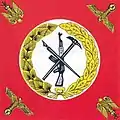 People's Liberation Army Flag
People's Liberation Army Flag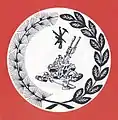 Anti-Aircraft Corps
Anti-Aircraft Corps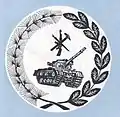 Armored Corps
Armored Corps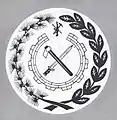 Engineering and Support Regiment
Engineering and Support Regiment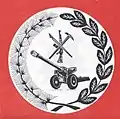 Artillery Corps
Artillery Corps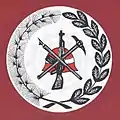 Security Police Corps
Security Police Corps People's Liberation Army 1976 Flag Version - Tanukh Brigade
People's Liberation Army 1976 Flag Version - Tanukh Brigade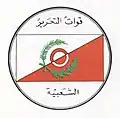 Popular Liberation Forces
Popular Liberation Forces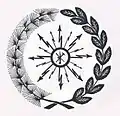 Signal Corps
Signal Corps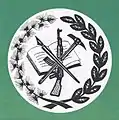 Military School
Military School War of 1958 Veterans' association
War of 1958 Veterans' association
Origins
Although the PSP was officially a secular political party, its military wing was not only well-organized, but also one of the largest sectarian militias in Lebanon. It was first founded unofficially by the Party's president Kamal Jumblatt at the height of the 1958 civil war with a strength of about 1,000–2,000 militiamen, which fought alongside the Pan-Arab/leftist anti-government forces against the Lebanese Army, and the pro-government conservative Christian and Muslim militias in Beirut and the Chouf District.
Disbanded upon the conclusion of the war, the PSP was left without an official paramilitary branch until early 1975, when – despite Kamal Jumblatt's initial reluctance to engage in paramilitarism – the Party's leadership board decided to quietly raise a new militia force with the help of the Palestine Liberation Organization or PLO (mainly from Fatah, PFLP and DPFLP) in response to the Christian rightist Parties' own clandestine military build-up.[1] Initial progress was slow, however, since the PSP was only able to gather a few hundred militiamen and because of the secrecy surrounding the formation of its militia, it even lacked an official title. Under Kamal Jumblatt's leadership, the PSP was a major element in the Lebanese National Movement (LNM) alliance, which supported the recognition of Lebanon's Arab identity and sympathised with the Palestinians. When the Lebanese Civil War broke out in April 1975, as a member of the LNM the PSP was an active founder of the movement's military wing, the Joint Forces (LNM-JF).
In 1976, following an open appeal by Kamal Jumblatt urging Lebanese Muslim youths to join the LNM-JF militias, the PSP's own military wing was expanded and re-organized, being officially established on August 17 of that year as the People's Liberation Army.[2] By early 1977, the PLA mustered 2,500–3,000 lightly-armed fighters drawn from the Druze and Shia Muslim communities of the Chouf.[3][4][5][6] Other sources however, place its numbers as high as 5,000.[7][8]
Military structure and organization
In 1975–77 the PLA was a predominantly infantry force, loosely organized into company- or battalion-sized formations provided with light weapons drawn from PLO stocks or pilfered from LAF and ISF barracks. After suffering casualties during the Israeli invasion of Lebanon of June 1982, the PLA was quietly re-organized that year by Walid Jumblatt, who turned it into a disciplined fighting force provided with Soviet-made armoured vehicles, field guns, Howitzers and MBRLs.
Headquartered at the Druze town of Baakline in the Chouf, the PSP militia by 1983 aligned 16,000–17,000 troops, consisting of 5,000–6,000 uniformed regulars backed by 12,000 male and female reservists[9] staffed by a qualified, Libyan- and Soviet-trained Officer corps; other Druze officer cadets received their instruction in a PSP-run Military School set up at the town of Debbiyeh, also in the Chouf.[10] The PLA absorbed many Druze soldiers which had served with the Lebanese Arab Army (LAA) upon its forceful disbandement in 1977-78,[11] being subsequently enlarged in the wake of the Mountain War with the inclusion of a number of Druze officers, NCOs and enlisted men from the Lebanese Army's Fourth Brigade after its disintegration in February 1984.[12][13] During that conflict, the PLA also received the active support of the 1,800 men-strong, primarily Druze Eleventh Brigade commanded by Colonel Amin Qadi, stationed at Hammana and Beiteddine.[14][15][16][17][18] Although its membership and command structure was predominantly Druze, the PLA did included a number of Sunnis and Shi'ites in their ranks; most Druze recruits continued to come from the Mountain and, until the return of the Syrian Army in 1987, from the Sanayeh (Kantari) and the seafront quarters of West Beirut.[8]
Branches of service
The PLA was structured along conventional lines, comprising several branches of service and support units. The "Commando" and Infantry formations were organized into independent battalions, regiments or brigades assigned to a specific area of military operations or "sector" (e.g. "Beirut Sector"), whilst specialized technical services consisted of:
- the Infantry Corps (Arabic: سلاح المشاة | Silah al-Moushat)
- the Armored Corps (Arabic: سلاح مدرع | Silah al-Moudara'a)
- the Artillery Corps (Arabic: سلاح المدفعية | Silah al-Madfa'aiya)
- the Anti-Aircraft Corps (Arabic: سلاح مضاد للطائرات | Silah Moudadoun lil Tayirat)
- the Rocket Corps (Arabic: سلاح الصواريخ | Silah al-Sawarikh)
- the Signal Corps (Arabic: فيلق الإشارة | Faylaq al-Ichara)
- the Logistics Corps (Arabic: سلاح اللوجستيات | Silah al-luwjustayat)
- the Engineering and Support Regiment (Arabic: فوج الهندسة والدعم | Fawj al-Hindasat Waldem)
- the Security Police Corps (Arabic: فيلق شرطة الأمن | Faylaq Shurtat al-Amn) – Military Police.
Units
- the Tanukh Brigade (Arabic: لواء تنوخ | Liwa' Tanukh)
- the Popular Liberation Forces – PLF (Arabic: قوات التحرير الشعبية | Quwwat al-Tahrir al-Sha'abya)
- the War of 1958 Veterans' association (Arabic: حرب 1958 جمعية المحاربين القدامى | Harb 1958 Jameiat al-Muharibin al-Qudama'a)
- the Martyr Kamal Jumblatt Forces (Arabic: قوات الشهيد كمال جنبلاط | Quwwat al-Shahid Kamal Junblat) – "Commando" unit attached to the Popular Liberation Forces.
Military facilities
- PLA Military School (Debbiyeh, Chouf District)
- Jal al-Baar barracks (Beirut)
List of PLA Commanders
- Kamal Jumblatt (1975–1977)
- Walid Jumblatt (1977–1990)
Weapons and equipment
Besides Palestinian and Syrian backing, the collapse of the Lebanese Armed Forces (LAF) and Internal Security Forces (ISF) in January 1976 allowed the PSP/PLA to seize some weapons and vehicles from their barracks and police stations, though they received further military assistance from Libya, Iraq, East Germany, and the USSR.[21] Additional weaponry, vehicles and other, non-lethal military equipments were procured in the international black market.
Small-arms
PLA infantry units were provided with a variety of small-arms, comprising Mauser Gewehr 98 and Karabiner 98k, Lee-Enfield, Berthier 1907/15 – M16 Lebel, MAS-36 and US M1917 bolt action rifles, MAS-49, M1 Garand (or its Italian-produced copy, the Beretta Model 1952) and SKS semi-automatic rifles, AMD-65 assault carbines, Heckler & Koch G3,[22] FN FAL, M16A1, AK-47 and AKM assault rifles (other variants included the Zastava M70, Chinese Type 56, Romanian Pistol Mitralieră model 1963/1965,[23] Bulgarian AKK/AKKS and former East German MPi-KMS-72 assault rifles).[24] Submachine guns and shotguns, such as the PPSh-41,[25] Beretta Model 12, Socimi Type 821 and Remington Model 870 were employed by PLA bodyguard units. Several models of handguns were used, such as Colt Cobra .38 Special snub-nose revolvers,[26] Tokarev TT-33, CZ 75, FN P35 and MAB PA-15 pistols. Squad weapons consisted of Bren Mk. I .303 (7.7mm), MG 34, RPK, RPD,[26] PK/PKM, FN MAG and M60 light machine guns, with heavier Browning M1919A4 .30 Cal, Browning M2HB .50 Cal, SG-43/SGM Goryunov and DShK machine guns being employed as platoon and company weapons. SIG SG 542 assault rifles fitted with sniper scopes were used for sniping.
Grenade launchers and portable anti-tank weapons included M79, M72 LAW and RPG-7 rocket launchers whilst crew-served and indirect fire weapons comprised 82-BM-41 (M-1937) 82 mm mortars, 2B14-1 Podnos 82 mm mortars and 120-PM-43 (M-1943) 120 mm heavy mortars, plus SPG-9 73 mm,[27] B-10 82mm, B-11 107mm and M40A1 106mm[28] recoilless rifles (often mounted on technicals).
Armoured and transport vehicles
The PSP militia fielded by 1977 a small mechanized corps made of Panhard AML-90[29][30][31] and Staghound armoured cars, M42 Duster SPAAGs and M113 armored personnel carriers[30] seized from the Lebanese Army in February 1976, plus a fleet of gun trucks or technicals. The latter consisted of US Willys M38A1 MD jeeps,[27] Land-Rover series II-III, Toyota Land Cruiser (J40),[32] Peugeot 404, GMC Sierra Custom K25/K30, and Jeep Gladiator J20 light pickup trucks[30] and M35A1 2½-ton (6x6) military trucks,[30] equipped with heavy machine guns, recoilless rifles, and Anti-aircraft autocannons.[33] These vehicles were partially supplanted in the early 1980s by new models, such as Jeep CJ-5 and CJ-8 (Civilian versions of the Willys M38A1 MD jeep),[34] Toyota Land Cruiser (J45), Toyota Land Cruiser (J55), Toyota Land Cruiser (J70), Nissan Patrol 160-Series (3rd generation),[30] and Datsun 720 pickup trucks,[35] whilst the disintegration of the Fourth Brigade allowed the PLA to seize a number of US M151A2 jeeps, M880/M890 Series CUCV, Chevrolet C-20 Scottsdale[36] and Dodge Ram (1st generation) pickup trucks, and M35A2 2½-ton cargo trucks, which they turned into technicals by arming them with Heavy machine guns, recoilless rifles and AA autocannons. They also captured two Alvis Saladin armoured cars, seven US-made M48A5 main battle tanks (MBTs),[37] AMX-13 light tanks,[37] and additional M113 APCs[30] for their own armoured corps.
The PLA's armoured units were further strengthened in 1983 with the arrival of some 70 T-55A MBTs,[38][39] BTR-152V1,[40] BTR-60PB,[40] and BMP-1[40] APCs and ZSU-23-4M Shilka SPAAGs supplied on loan by Syria and the USSR, which they employed in the War of the Camps waged in 1985–88 against Nasserist and PLO militias in west Beirut. For logistical support, the PLA relied on Soviet UAZ-469 light utility vehicles, Nissan Patrol 160-Series (3rd generation) hardtop light pickups, Syrian-supplied Mercedes-Benz Unimog 416 and GAZ-66 light trucks, Soviet ZIL-131 (6x6) military trucks, captured Israeli AIL M325 Command Cars ('Nun-Nun')[40][41] and US M35A2 2½-ton (6x6) military trucks. A number of Soviet BTS-4 Armoured Recovery Vehicles (ARV) were also employed.
Artillery
The PLA also fielded a powerful artillery corps equipped with obsolete Soviet ZiS-2 57mm[42] and ZiS-3 76.2mm anti-tank guns, M101A1 105mm towed field howitzers, 122 mm howitzer 2A18 (D-30)[43] and 130 mm towed field gun M1954 (M-46) pieces,[44][42] whilst the rocket corps fielded truck-mounted BM-11 122mm and BM-21 Grad 122mm[45] and towed BM-12 (Chinese Type 63 107mm) MBRLs.[42] Yugoslav Zastava M55 A2 20mm,[46][47] Soviet ZPU (ZPU-1, ZPU-2, ZPU-4) 14.5mm[48] and ZU-23-2 23mm Anti-aircraft autocannons (mostly mounted on technicals and BTR-152 and M113 APCs), and towed AZP S-60 57mm anti-aircraft guns were employed in both air defense and direct fire supporting roles. In addition to AA guns and autocannons, the PLA received from Syria a number of man-portable, shoulder-launched Soviet SA-7 Grail surface-to-air (SAM) missiles which were used to bring down two Lebanese Air Force Hawker Hunter fighter jets and one Israeli Air Force (IAF) Kfir fighter-bomber jet during the 1983–84 Mountain War (the pilot was rescued by the Lebanese Army).[49][50][51][52]
Administrative organization and illegal activities
The stronghold of the PSP/PLA laid in the Jabal Barouk area within the Chouf, which they turned into a semi-autonomous canton in the early 1980s, known unofficially as the 'Druze Mountain' (Arabic: Jabal al-Duruz). Centred at the Druze town of Baakline – the PSP's political and military HQ – the canton comprised the Chouf District proper, including the historic towns of Moukhtara (the Jumblatt family's feudal seat near Beiteddine), Deir al-Qamar, Aley and Bhamdoun, and the Iqlim al-Kharrub coastal enclave south of Beirut, which was added to the canton in March 1984. At west Beirut, the PLA controlled since May 1985 the Druze-populated Karakol quarter, parts of the Hamra district and a large portion of Rue Watta el-Msaytbi, the latter a small Druze street that housed the PSP's main political offices in the capital city.
From the Israeli withdrawal from the Chouf in 1983 to the end of the civil war in 1990, the PSP ran a highly effective and well-organized civil service, the "Civilian Administration of the Mountain" (CAM or CAOM), in the areas under its control. The CAM was set up on 1 October 1983 at Beiteddine, headed by an eight-man supreme council that included a central committee and a general congress.[53] Its own 23 bureaus staffed by 3,000 public employees provided everything from education to medical care and also employed 2,000 seasonal workers in agricultural and industrial projects in the Chouf.[8]
To finance the administration, a Druze-run Holding, the COGECO group, was made responsible for running illegal activities at the clandestine ports of Khalde and Jieh in the Iqlim al-Kharrub coastal enclave, which included the importation of fuel from Iran, drug-trafficking and gambling by a network of PSP-run Hotels and illegal Casinos. Additional revenues were generated by leaving tolls on the transit trade of agricultural products and other goods at a number of in-land PLA road checkpoints, whilst the expatriated Druze community in the United States provided financial support.
Beiteddine was also the home of the PSP/PLA media services, responsible for editing its official newspaper, "The News" (Arabic: Al-Anba'a) and operated since February 1984 their own radio station, the "Voice of the Mountain" (Arabic: Iza'at Sawt al-Djabal) or "La Voix de la Montagne" in French.[54][55][56]
Controversy
Historically, the Druze in Lebanon managed to maintain for centuries a small, hardy community in the Chouf Mountains overlooking Beirut surrounded by a sea of potential enemies, both Christian and Muslim, and they have a reputation of being savage fighters known for their tenacious battle spirit. Their esprit de corps and brutal methods often convinced their opponents to flee, whilst those who decided to stay and fight never lived to tell the tale.[57] However, the Lebanese Druze have also been amiable to whoever controls the Chouf region at any given time, and they were pragmatic with their dealings with foreign powers such as the Israelis, Americans and Syrians.[58]
Long-standing enemies since the 1860s, the Druze have always been at odds with the Maronites, and acts of barbarism on both sides have bedevilled their ability to co-exist for centuries past. On 16 March 1977, the PSP leader Kamal Jumblatt was ambushed and killed in his car near Baakline in the Chouf by unidentified gunmen (allegedly, fighters from the pro-Syrian faction of the Syrian Social Nationalist Party or SSNP, acting in collusion with the Syrian military commander of the Mount Lebanon region, Colonel Ibrahim Houeijy);[59][60][61][62][63] believing that the perpetrators were members of the predominately Christian Phalangist Kataeb Regulatory Forces (KRF) or Tigers Militias, PLA militiamen extracted swift retribution on the local Maronite population living in the intermixed towns and villages around Baakline. Despite the hasty dispatch on March 17 of 4,000 Syrian Army troops from the Arab Deterrent Force (ADF) to keep the peace in the Chouf, it is estimated that about 177–250 Maronite villagers were killed in reprisal actions at the towns of Moukhtara and Barouk, and at the villages of Mazraet el-Chouf, Maaser el-Chouf, Botmeh, Kfar Nabrakh, Machghara and Brih.[64][62][65][66]
During the Mountain War, the predominantly Maronite Lebanese Forces militia occupied the Chouf District and tried to impose its authority by force, allegedly killing some 145 Druze civilians at Kfar Matta in September 1983 (although other sources allege that the death toll mounted to 200 people).[67][68] The Lebanese Forces command later accused the Druze PLA of committing "unprecedented massacres" in the Chouf,[69][70] after Walid Jumblatt's militia forces overran between 31 August and 13 September 1983 sixty-two Maronite villages (including Bmarian, Bireh, Ras el-Matn, Maaser Beit ed-Dine, Chartoun, Ain el-Hour, Bourjayne, Fawara, and Maaser el-Chouf), slaughtered 1,500 people and drove another 50,000 out of their homes in the mountainous areas east and west of Beirut.[71][72]
Like other Lebanese militias, the PLA was also involved in the kidnapping of political adversaries. In one occasion, on 23 September 1984 PLA fighters attempted to seize two Lebanese Army soldiers posted on sentry duty outside the Barbir Hospital in the Ouza'i district of West Beirut, though the latter managed to escape on foot towards the Army-manned Ojjeh checkpoint situated nearby at the Green Line, despite being pursued by their captors in a civilian car.[73] Later on 8 September 1988, the deputy for Jezzine in the Lebanese Parliament, Dr Farid Serhal, was seized by PLA militiamen at a checkpoint also in the Ouza'i district of West Beirut and driven off to the Le Bristol Hotel Beirut in Rue Madame Curie, Ras Beirut, where he was temporarily held hostage.[74]
The PLA in the Lebanese Civil War
The early phase 1975–1982
When the Lebanese Civil War broke out in April 1975, as a member of the LNM the Druze PSP/PLA was an active founder of its military wing, the Joint Forces (LNM-JF), and during the 1975–77 phase of the Lebanese Civil War, they were heavily committed in several battles. At the Battle of the Hotels in October 1975, PLA militiamen engaged Christian Kataeb Regulatory Forces (KRF) and Tigers Militia fighters,[75] and later participated in the 'Spring Offensive' held against East Beirut and Mount Lebanon, battling the Lebanese Front militias at the Aley District in March–April 1976. At the former location, the PLA militia allied with the Lebanese Arab Army (LAA) battled Internal Security Forces (ISF) and Army of Free Lebanon's (AFL) units during an unsuccessful attempt to raid the AFL Headquarters at the Shukri Ghanem Barracks complex in the Fayadieh district.[76][77]
Kamal Jumblatt's opposition to the Syrian military intervention of June 1976 in support of the official Lebanese Government and his adversaries of the Christian Lebanese Front militias, resulted in the PSP/PLA fighting Syrian Army troops at the Battle of Bhamdoun in the Chouf District. Between 13 and 17 October 1976, the Druze PLA and their allies of the Sunni Al-Mourabitoun militia, the LAA and the PLO inflicted heavy losses on the Syrian 3rd Armoured Division when they tried to enter Bhamdoun by force.[78][79][80]
The Mountain War 1983–84
During the June 1982 Israeli invasion of Lebanon the PSP/PLA remained neutral, with Walid Jumblatt refusing to allow PLO units to operate within Druze territory and the PSP militia forces did not fought against the Israel Defense Forces (IDF), even though they supported their arch-enemies the Maronite Kataeb Party and its military arm, the Lebanese Forces (LF) militia.[81] However, when President Amine Gemayel refused to grant the Druze community the expected political representation, Walid Jumblatt formed in response on July 1983 a Palestinian- and Syrian-backed military coalition, the Lebanese National Salvation Front (LNSF), that rallied several Lebanese Muslim and Christian parties and militias opposed to the U.S.-sponsored May 17 Agreement with Israel. Led by Jumblatt's PSP/PLA, the alliance gathered its rivals of the Druze Yazbaki clan, the Syrian Social Nationalist Party (SSNP), the Al-Mourabitoun and the Lebanese Communist Party (LCP)/Popular Guards, which fought the LF, the Lebanese Armed Forces (LAF) and the U.S. Marines contingent of the Multinational Force (MNF II) in the Chouf and Aley Districts and at West Beirut between September 1983 and February 1984.[81][82][83]
On July 24, 1984 the PLA battled the Sunni Al-Mourabitoun militia at West Beirut, until the fighting was curbed by the intervention of the predominately Shia Sixth Brigade.[84]
The War of the Camps 1985–87
In March–April 1985, the PSP/PLA joined in a Syrian-backed coalition with the Popular Nasserist Organization (PNO), the Al-Mourabitoun and the Shi'ite Amal Movement, which defeated the Christian Lebanese Forces (LF) attempts to establish bridgeheads at Damour and Sidon.[85] As soon this battle ended, they joined in May another powerful coalition that gathered Amal and LCP/Popular Guards militia forces backed by Syria,[86] the Lebanese Army,[87] and anti-Arafat dissident Palestinian guerrilla factions pitted against an alliance of pro-Arafat Palestinian refugee camps' PLO militias, the Al-Mourabitoun, the Communist Action Organization in Lebanon (OCAL), the Sixth of February Movement and the Kurdish Democratic Party – Lebanon (KDP-L). Although the PSP/PLA helped Amal in defeating the Al-Mourabitoun after a week of heavy fighting,[88] they were reluctant to suppress altogether the PLO and KDP-L militias defending the refugee camps, preferring instead to stay out of the fight and remain militarily neutral in the subsequent conflict. Despite the PLA's "neutrality" posture, however, they did allowed the pro-Arafat Palestinian fighters to station their artillery on Druze-controlled areas.
Between July and November 1985, the PLA battled Amal for the control of some key positions in West Beirut previously held by the Multinational Force (MNF II), until a cease-fire agreement mediated by the Syrian military intelligence chief in Lebanon, Major general Ghazi Kanaan, was signed in late November. The terms of the agreement clearly favored Amal, which forced Walid Jumblatt on November 24 to publicly "reconsider" the military presence of his own PSP/PLA militia in the western sector of the Lebanese Capital.
In January 1987, PLA bodyguards provided protection to the Church of England's special envoy Terry Waite during his trip to West Beirut to negotiate the release of several British hostages then held by the Islamic Jihad Organization (IJO), though they were unable to prevent him of being tricked and abducted in turn by the IJO on January 20. The PLA also provided security to the Commodore Hotel at Rue Baalbek on the Hamra district of West Beirut, which housed many foreign correspondents on assignment in the war-torn Lebanese Capital and served as an international news media center.
The following month, the PLA and Amal again turned against each other in what became known as the "War of the Flag". The conflict was sparked by an incident on February 22, when a PLA fighter walked to the Channel 7 TV station (French: Télé Liban – Canal 7) building in the Tallet el-Khayat quarter[89] and replaced the Lebanese national flag hoisted there by the PSP flag, which was interpreted by Amal militiamen as a deliberate act of provocation. A new round of brutal fighting soon spread throughout western Beirut, and although Amal forces initially managed to restore the Lebanese national flag on the Channel 7 building, they were subsequently overpowered by an alliance of PLA, LCP/Popular Guard and SSNP militias, who quickly seized large portions of West Beirut. Eventually, the fighting was curbed by the massive deployment at West Beirut of Syrian troops under the command of Maj. Gen. Kanaan, assisted by Lebanese Internal Security Forces (ISF) gendarmes.
That same year, the PLA fought again the Lebanese Army in the Aley District, after the predominately Christian Maronite Fifth brigade had been deployed at the strategic town of Souk El Gharb to prevent Druze artillerymen from shelling the Lebanese Capital.[90]
The later years 1988–1990
During the 1988–1990 Liberation War, the PLA fought alongside pro-Syrian Lebanese Forces – Executive Command (LFEC) and Palestinian militias backed by the Syrian Army against General Michel Aoun's Lebanese Army troops at the second battle of Souk El Gharb on August 13, 1989.[91][92] Later on October 13, 1990, the PLA participated in the final offensive that brought a decisive end to the Lebanese Civil War, assisting Syrian Social Nationalist Party (SSNP) and LFEC militiamen and Syrian troops in the capture of Gen. Aoun's HQ at the Presidential Palace in Baabda.
Disbandment
Upon the end of the war in October 1990, PSP/PLA militia forces operating in Beirut and the Chouf were ordered by the Lebanese Government on March 28, 1991 to disband and surrender their heavy weaponry by April 30 as stipulated by the Taif Agreement.[93] A total of 3,300 former PLA militiamen, including 50 officers, requested integration into the structure of the Lebanese Armed Forces (LAF), but only 1,300 of these applicants were actually integrated. Some 800 ex-PLA fighters joined the re-formed Lebanese Army during the first stage, 160 of whom were attached to the Internal Security Forces (ISF) or the Lebanese Customs Administration. At a later stage, probably towards the beginning of 1992, an additional 500 Druze militiamen were integrated into the LAF and the ISF, with the process being completed by mid-1994.[94] Despite the order to disarm, some PSP/PLA guerrilla cells continued to operate in southern Lebanon against the Israel Defense Forces (IDF) and their South Lebanon Army (SLA) proxies in the "Security Belt" until the final Israeli pull-out in May 2000. The PLA is no longer active.
Uniforms and insignia
Usually, PLA militiamen wore in the field a mix of military uniforms, western civilian clothes and traditional Druze garb,[95] though they were known to have worn a variety of battle dress, depending on whom they allied to and what other armed forces were occupying their territory.[26]
Fatigue clothing
Besides ex-Lebanese Army olive-green fatigues,[96] a light khaki work uniform was also issued to PLA combat troops, which consisted of a cotton shirt and pants. The shirt featured a six-buttoned front and two pleated breast pockets closed by pointed flaps, was provided with shoulder straps and had long sleeves with buttoned cuffs. It was worn with matching trousers, which had two side slashed pockets, two pleated cargo pockets closed by straight, dual-buttoned flaps, and two internal pockets at the back, closed by pointed flaps. Camouflage uniforms consisted of surplus US Highland pattern (ERDL 1948 Leaf pattern or "Woodland pattern") fatigues, Italian M1929 Telo mimetico fatigues,[23] West German Bundeswehr 1956 Splinter pattern jackets, Czechoslovakian Vz 60 "Salamander" (Mlok) pattern fatigues, Syrian copies of the Pakistani Brushstroke (nicknamed "Wisp") fatigues,[97] captured U.S. Woodland Battle Dress Uniforms (BDU)[26] and Palestinian Brushstroke fatigues; the latter was a PLO Brushstroke variation incorporating very dark olive and purplish-brown strokes with very long and thin brush trails on a sandy-colored background. The PLA did develop through their own unique camouflage pattern, a hybrid lizard/Pakistani brushstroke design, which was locally-produced. T-shirts in US Highland pattern were sometimes seen. Syrian-supplied OG US M-1965 field jackets,[95] Israeli olive Dubon Parkas[98][23] and ex-PLO Pakistan Army olive-brown woollen pullovers (a.k.a. 'woolly-pullies') provided with breast pockets and shoulder straps, were worn in cold weather.
Headgear
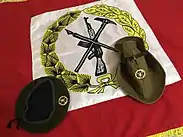
Usual headgear consisted of ex-Lebanese Army OG Baseball caps and US BDU caps, and black, midnight blue or olive green berets worn French-style, pulled to the left, although "Commando" units wore red or maroon berets instead.[99] Soviet brimmed, circular sun hats in khaki cotton (Russian: Panamanka) were worn in the summer, replaced by the traditional Druze tan woollen cap in the winter;[98] a Ushanka-style shaggy black fur hat was sometimes seen. A black-and-white or red-and-white kaffiyeh was also worn around the neck as a foulard or wrapped around the head to conceal identity. In the field, PLA infantrymen could be found wearing a variety of helmet types, consisting of Syrian-supplied Soviet SSh-60 and SSh-68 steel helmets or captured US M-1 and French M1951 NATO (French: Casque Mle 1951 OTAN) steel helmets, and Israeli Orlite OR-201 (Model 76) ballistic helmets. Armoured crews received Soviet black tanker's padded cloth helmets or wore US fibreglass "bone dome" Combat Vehicle Crewman (CVC) helmets and CTVC DH-132 helmets in ballistic Kevlar captured from the Lebanese Army. In addition to helmets, some PLA militiamen also used captured flak jackets, either the Ballistic Nylon US M-1952/69 "Half-collar" vest and the Israeli-produced Kevlar Rabintex Industries Ltd Type III RAV 200 Protective Vest ("Shapats").
Footwear
Footwear was equally diverse. Black leather combat boots came from Lebanese Army stocks[100] or were provided by the Syrians, complemented by Israeli black or brown leather paratrooper boots captured from the Lebanese Forces and Syrian high-top Pataugas olive canvas-and-rubber patrol boots. Several models of civilian sneakers or "trainers" and rubber gumboots were also used by PLA militiamen.[49]
Accoutrements
Web gear consisted on the US Army M-1956 Load-Carrying Equipment (LCE) in khaki cotton canvas and the All-purpose Lightweight Individual Carrying Equipment (ALICE) in OG Nylon captured from the Lebanese Army, ChiCom chest rigs in khaki cotton fabric for the AK-47 assault rifle and the SKS semi-automatic rifle, Soviet three-cell AK-47 magazine pouches in Khaki or OG canvas, and even IDF olive green Nylon Ephod Combat Vests; several variants of locally-made, multi-pocket chest rigs and assault vests in canvas or Nylon were also widely used.[95]
Insignia
Apart from Corps' and units' flags, the PLA apparently never devised a system of rank, branch or unit insignia of their own, although its personnel did wear a variety of field recognition signs. Berets were worn with the standard PLA cap badge placed above the right eye.[101] Issued in gilt metal for all-ranks, it was sometimes found pinned to Soviet sun hats and Baseball caps. White, red, olive green and black T-shirts stamped with either the PSP crest, the PLA badge or the Party leaders' effigy were commonly worn by Druze fighters.[95] A red brassard of roughly triangular shape and attached to a shoulder strap, bearing the stamped full-colour Progressive Socialist Party crest with the initials "PSP" below, flanked by the inscription of the sector to which the bearer was assigned to and surmounted by another inscription bearing "People's Liberation Army" in Arabic script, was worn on the left arm.[23] Steel helmets painted in red, marked with white stripes at the sides and the initials "PSP" were issued to Security Police Corps' troopers assigned patrol duties in urban areas.
See also
- Amal Movement
- Al-Mourabitoun
- Battle of the Hotels
- Holiday Inn Beirut
- Lebanese Arab Army
- Lebanese Civil War
- Lebanese Communist Party
- Lebanese Forces (militia)
- Lebanese National Movement
- Le Commodore Hotel Beirut
- Terry Waite
- Mountain War (Lebanon)
- Popular Guard
- Vanguard of the Maani Army (Movement of the Druze Jihad)
- War of the Camps
- Weapons of the Lebanese Civil War
- 2008 conflict in Lebanon
- 4th Infantry Brigade (Lebanon)
- 7th Infantry Brigade (Lebanon)
- 11th Infantry Brigade (Lebanon)
Notes
- Jureidini, McLaurin, and Price, Military Operations in Selected Lebanese Built-Up Areas (1979), p. 2.
- Jureidini, McLaurin, and Price, Military Operations in Selected Lebanese Built-Up Areas (1979), Appendix B, B-39.
- Khalidi, Conflict and Violence in Lebanon (1984), p. 77.
- McGowan, Roberts, Abu Khalil, and Scott Mason, Lebanon: A Country Study (1989), pp. 240–241.
- Collelo, Lebanon: A Country Study (1989), pp. 240–241.
- O'Ballance, Civil War in Lebanon (1998), p. 19.
- El-Kazen, The Breakdown of the State in Lebanon (2000), p. 302.
- Bicard, Prospects for Lebanon – The Demobilization of the Lebanese Militias, p. 9.
- Makdisi and Sadaka, The Lebanese Civil War, 1975–1990 (2003), p. 44, Table 1: War Period Militias.
- Bicard, Prospects for Lebanon – The Demobilization of the Lebanese Militias, p. 11.
- Barak, The Lebanese Army – A National institution in a divided society (2009), p. 104.
- O'Ballance, Civil War in Lebanon (1998), p. 136.
- Church, George (27 February 1984). "Failure of a Flawed Policy". Time. Retrieved 17 March 2013.
- Collelo, Lebanon: a country study (1989), pp. 224-225.
- Rolland, Lebanon: Current Issues and Background (2003), pp. 185-186.
- Barak, The Lebanese Army – A National institution in a divided society (2009), p. 155.
- Brinkley, Joel (17 February 1984). "As the Lebanese Army caves in, U.S. evaluates training program; American effort said to have overlooked doubts of officers". The New York Times.
- https://www.globalsecurity.org/military/world/lebanon/army-orbat-1.htm
- Hokayem, L'armée libanaise pendant la guerre: un instrument du pouvoir du président de la République (1975-1985) (2012), p. 102, note 170.
- Hokayem, L'armée libanaise pendant la guerre: un instrument du pouvoir du président de la République (1975-1985) (2012), p. 102, note 170.
- El-Kazen, The Breakdown of the State in Lebanon (2000), p. 303.
- Thompson, The G3 Battle Rifle (2019), p. 29.
- Katz and Volstad, Arab Armies of the Middle East Wars 2 (1988), p. 46, Plate G5.
- Katz and Volstad, Arab Armies of the Middle East Wars 2 (1988), p. 47, Plate H3.
- McNab, Soviet Submachine Guns of World War II: PPD-40, PPSh-41 and PPS (2014), p. 68.
- Katz, Russel, and Volstad, Armies in Lebanon (1985), pp. 44–45, Plate G3.
- El-Assad, Civil Wars Volume 1: The Gun Trucks (2008), p. 135.
- El-Assad, Civil Wars Volume 1: The Gun Trucks (2008), p. 133.
- Hamizrachi, The Emergence of South Lebanon Security Belt (1984), pp. 55–89.
- Kassis, 30 Years of Military Vehicles in Lebanon (2003), p. 57.
- Badran, Lebanon: Liberation, Conflict, and Crisis (2010), pp. 50–52.
- Neville, Technicals: Non-Standard Tactical Vehicles from the Great Toyota War to modern Special Forces (2018), pp. 22-23, Plate C2.
- El-Assad, Civil Wars Volume 1: The Gun Trucks (2008), p. 129.
- Neville, Technicals: Non-Standard Tactical Vehicles from the Great Toyota War to modern Special Forces (2018), p. 9.
- El-Assad, Civil Wars Volume 1: The Gun Trucks (2008), pp. 55–57.
- Neville, Technicals: Non-Standard Tactical Vehicles from the Great Toyota War to modern Special Forces (2018), p. 15.
- Kassis, 30 Years of Military Vehicles in Lebanon (2003), p. 59.
- Dunord, "Liban: Les milices rendent leurs armes", RAIDS magazine (1991), p. 31.
- Kassis, 30 Years of Military Vehicles in Lebanon (2003), pp. 60–61.
- Kassis, 30 Years of Military Vehicles in Lebanon (2003), p. 58.
- El-Assad, Civil Wars Volume 1: The Gun Trucks (2008), pp. 99–101.
- Kassis, 30 Years of Military Vehicles in Lebanon (2003), p. 61.
- Éric Micheletti, Bataille d'Artillerie, RAIDS magazine (1989), p. 14.
- Guest, Lebanon (1994), p. 105.
- Mahé, La Guerre Civile Libanaise, un chaos indescriptible! (1975–1990) (2014), p. 81.
- Neville, Technicals: Non-Standard Tactical Vehicles from the Great Toyota War to modern Special Forces (2018), p. 15.
- Kassis, Invasion of Lebanon 1982 (2019), p. 233.
- Neville, Technicals: Non-Standard Tactical Vehicles from the Great Toyota War to modern Special Forces (2018), pp. 15; 22-23, Plate C2.
- Guest, Lebanon (1994), p. 106. This source reports the loss as an American-made F-16, though it was actually an Israeli-made Kfir.
- https://www.nytimes.com/1983/11/21/world/israeli-jets-bomb-palestinian-bases-in-lebanon-hills.html
- https://www.jta.org/1983/11/21/archive/israeli-plane-shot-down-by-surface-to-air-missiles-over-lebanon
- https://www.washingtonpost.com/archive/politics/1983/11/21/israelis-bomb-lebanese-sites-lose-one-plane/72852c73-52a8-4913-9901-3278bfdb9a7c/
- O'Ballance, Civil War in Lebanon (1998), p. 132.
- Mekhon Shiloaḥ le-ḥeḳer ha-Mizraḥ ha-tikhon ṿe-Afriḳah, and Merkaz Dayan le-ḥeḳer ha-Mizraḥ ha-Tikhon ṿe-Afriḳah (Universiṭat Tel-Aviv). Middle East Contemporary Survey. New York: Holmes & Meier, 1986. p. xxx
- Fisk, Pity the Nation: Lebanon at War (2001), p. 145.
- Ibrahim, Roula (23 September 2012). "Walid Jumblatt and His Two Right Hands". Al Akhbar. Archived from the original on 27 February 2013. Retrieved 6 October 2012.
- El-Assad, Civil Wars Volume 1: The Gun Trucks (2008), p. 98.
- Katz and Volstad, Arab Armies of the Middle East Wars (2) (1988), p. 37.
- Tim Llewellyn (1 June 2010). Spirit of the Phoenix: Beirut and the Story of Lebanon. I.B.Tauris. pp. xiii. ISBN 978-1-84511-735-1. Retrieved 15 March 2013.
- Knudsen, Are (2010). "Acquiescence to Assassinations in Post-Civil War Lebanon?". Mediterranean Politics. 15 (1): 1–23. doi:10.1080/13629391003644611. S2CID 154792218.
- Collelo, Lebanon: A Country Study (1989), p. 241.
- Rabinovich, The War for Lebanon (1989), p. 77.
- Menargues, Les Secrets de la guerre du Liban (2004), p. 50.
- Jureidini, McLaurin, and Price, Military Operations in Selected Lebanese Built-Up Areas (1979), Appendix B, B-45.
- Labaki & Abou Rjeily, Bilan des guerres du Liban (1975-1990) (1993), p. 58.
- O'Ballance, Civil War in Lebanon (1998), p. 62.
- O'Ballance, Civil War in Lebanon (1998), pp. 129; 137–138.
- Hinson, Crimes on Sacred Ground: Massacres, Desecration, and Iconoclasm in Lebanon’s Mountain War 1983-1984 (2017), p. 51.
- O'Ballance, Civil War in Lebanon (1998), p. 129.
- Jago Salmon, Massacre and Mutilation: Understanding the Lebanese Forces through their use of violence, Workshop on the 'techniques of Violence in Civil War', PRIO, Oslo, August 20–21, 2004, p. 10, footnote 19.
- Laffin, The War of Desperation: Lebanon 1982-85 (1985), pp. 184-185.
- Hinson, Crimes on Sacred Ground: Massacres, Desecration, and Iconoclasm in Lebanon’s Mountain War 1983-1984 (2017), p. 8.
- Hokayem, L'armée libanaise pendant la guerre: un instrument du pouvoir du président de la République (1975–1985) (2012), p. 97.
- An-Nahar (Beirut), 14 September 1988, p. 3.
- O'Ballance, Civil War in Lebanon (1998), p. 29.
- Jureidini, McLaurin, and Price, Military Operations in Selected Lebanese Built-Up Areas (1979), pp. 20–23.
- Barak, The Lebanese Army – A National institution in a divided society (2009), p. 115.
- Jureidini, McLaurin, and Price, Military Operations in Selected Lebanese Built-Up Areas (1979), pp. 27–28; Appendix B, B-42.
- Zaloga, Tank Battles of the Mid-East Wars (2003), p. 7.
- Naud, La Guerre Civile Libanaise – 1re partie: 1975–1978, pp. 11–13.
- Katz, Russel and Volstad, Armies in Lebanon 1982–84 (1985), p. 33.
- Guest, Lebanon (1994), p. 109.
- DoD Commission on Beirut International Airport December 1983 Terrorist Act
 This article incorporates text from this source, which is in the public domain.
This article incorporates text from this source, which is in the public domain. - O'Ballance, Civil War in Lebanon (1998), p. 146.
- O'Ballance, Civil War in Lebanon (1998), p. 156.
- Joe Stork, "The War of the Camps, The War of the Hostages" in MERIP Reports, No. 133. (June 1985), pp. 3–7, 22.
- O'Ballance, Civil War in Lebanon (1998), p. 158.
- William E. Smith, "Lebanon: A Country's Slow Death", Time, April 29, 1985, p. 46.
- Hokayem, L'armée libanaise pendant la guerre: un instrument du pouvoir du président de la République (1975–1985) (2012), p. 27.
- Collelo, Lebanon: A Country Study (1989), p. 223.
- Micheletti and Debay, "Victoire a Souk El Gharb – la 10e Brigade sauve le Liban", RAIDS magazine (1989), pp. 18-24.
- Barak, The Lebanese Army – A National institution in a divided society (2009), p. 159.
- Barak, The Lebanese Army – A National institution in a divided society (2009), p. 173.
- Bicard, Prospects for Lebanon – The Demobilization of the Lebanese Militias, pp. 9–12.
- Katz and Volstad, Arab Armies of the Middle East Wars 2 (1988), p. 37.
- Katz, Russel, and Volstad, Armies in Lebanon (1985), pp. 44-45, Plate G3.
- Katz, Russel, and Volstad, Armies in Lebanon (1985), pp. 44-45, Plate G3.
- Katz, Russel, and Volstad, Armies in Lebanon (1985), p. 45, Plate G3.
- Katz and Volstad, Arab Armies of the Middle East Wars 2 (1988), p. 46, Plate G5.
- Katz, Russel, and Volstad, Armies in Lebanon (1985), pp. 44-45, Plate G3.
- Katz and Volstad, Arab Armies of the Middle East Wars 2 (1988), p. 46, Plate G5.
References
- Afaf Sabeh McGowan, John Roberts, As'ad Abu Khalil, and Robert Scott Mason, Lebanon: a country study, area handbook series, Headquarters, Department of the Army (DA Pam 550-24), Washington D.C. 1989. –
- Alain Menargues, Les Secrets de la guerre du Liban: Du coup d'état de Béchir Gémayel aux massacres des camps palestiniens, Albin Michel, Paris 2004. ISBN 978-2226121271 (in French)
- Beate Hamizrachi, The Emergence of South Lebanon Security Belt, Praeger Publishers Inc., New York 1984. ISBN 978-0-275-92854-4
- Boutros Labaki & Khalil Abou Rjeily, Bilan des guerres du Liban (1975-1990), Collection "Comprendre le Moyen-Orient", Editions L'Harmattan, Paris 1993. ISBN 978-2738415257 (in French)
- Chris McNab, Soviet Submachine Guns of World War II: PPD-40, PPSh-41 and PPS, Weapon series 33, Osprey Publishing Ltd, Oxford 2014. ISBN 9781782007944
- Edgar O'Ballance, Civil War in Lebanon, 1975–92, Palgrave Macmillan, London 1998. ISBN 0-333-72975-7
- Elizabeth Bicard, Prospects for Lebanon – The Demobilization of the Lebanese Militias, Centre for Lebanese Studies, Oxford (no date). ISBN 1 870552 64 4
- Éric Micheletti and Yves Debay, Liban – dix jours aux cœur des combats, RAIDS magazine n.º41, October 1989 issue. ISSN 0769-4814 (in French)
- Farid El-Kazen, The Breakdown of the State in Lebanon 1967-1976, I. B. Tauris, London 2000. ISBN 0-674-08105-6 –
- Fawwaz Traboulsi, Identités et solidarités croisées dans les conflits du Liban contemporain; Chapitre 12: L'économie politique des milices: le phénomène mafieux, Thèse de Doctorat d'Histoire – 1993, Université de Paris VIII, 2007. (in French) –
- Itamar Rabinovich, The war for Lebanon, 1970–1985, Cornell University Press, Ithaca and London 1989 (revised edition). ISBN 978-0-8014-9313-3, 0-8014-9313-7 –
- Jean Dunord, Liban: Les milices rendent leurs armes, RAIDS magazine n.º65, October 1991 issue. ISSN 0769-4814 (in French)
- Jennifer Philippa Eggert, Female Fighters and Militants During the Lebanese Civil War: Individual Profiles, Pathways, and Motivations, Studies in Conflict & Terrorism, Taylor & Francis Group, LLC, 2018. –
- John C. Rolland (ed.), Lebanon: Current Issues and Background, Nova Science Publishers, Hauppauge, New York 2003. ISBN 978-1-590-33871-1 –
- John Laffin, The War of Desperation: Lebanon 1982-85, Osprey Publishing Ltd, London 1985. ISBN 0 85045 603 7
- Joseph Hokayem, L'armée libanaise pendant la guerre: un instrument du pouvoir du président de la République (1975–1985), Lulu.com, Beyrouth 2012. ISBN 9781291036602, 1291036601 (in French) –
- Ken Guest, Lebanon, in Flashpoint! At the Front Line of Today's Wars, Arms and Armour Press, London 1994, pp. 97–111. ISBN 1-85409-247-2
- Leigh Neville, Technicals: Non-Standard Tactical Vehicles from the Great Toyota War to modern Special Forces, New Vanguard series 257, Osprey Publishing Ltd, Oxford 2018. ISBN 9781472822512
- Leroy Thompson, The G3 Battle Rifle, Weapon series 68, Osprey Publishing Ltd, Oxford 2019. ISBN 9781472828620
- Matthew Hinson, Crimes on Sacred Ground: Massacres, Desecration, and Iconoclasm in Lebanon's Mountain War 1983-1984, Honors Thesis Submitted to the Department of History, Georgetown University, 8 May 2017. –
- Moustafa El-Assad, Civil Wars Volume 1: The Gun Trucks, Blue Steel books, Sidon 2008. ISBN 9953-0-1256-8
- Naomi Joy Weinberger, Syrian Intervention in Lebanon: The 1975–76 Civil War, Oxford University Press, Oxford 1986. ISBN 978-0195040104, 0195040104
- Oren Barak, The Lebanese Army – A National institution in a divided society, State University of New York Press, Albany 2009. ISBN 978-0-7914-9345-8 –
- Rex Brynen, Sanctuary and Survival: the PLO in Lebanon, Boulder: Westview Press, Oxford 1990. ISBN 0 86187 123 5 –
- Robert Fisk, Pity the Nation: Lebanon at War, London: Oxford University Press, (3rd ed. 2001). ISBN 0-19-280130-9 –
- Paul Jureidini, R. D. McLaurin, and James Price, Military operations in selected Lebanese built-up areas, 1975–1978, Aberdeen, MD: U.S. Army Human Engineering Laboratory, Aberdeen Proving Ground, Technical Memorandum 11-79, June 1979.
- Philipe Naud, La Guerre Civile Libanaise – 1re partie: 1975–1978, Steelmasters Magazine, August–September 2012, pp. 8–16. ISSN 1962-4654 (in French)
- Samer Kassis, 30 Years of Military Vehicles in Lebanon, Beirut: Elite Group, 2003. ISBN 9953-0-0705-5
- Samer Kassis, Véhicules Militaires au Liban/Military Vehicles in Lebanon 1975–1981, Trebia Publishing, Chyah 2012. ISBN 978-9953-0-2372-4
- Samer Kassis, Invasion of Lebanon 1982, Abteilung 502, 2019. ISBN 978-84-120935-1-3
- Samuel M. Katz, Lee E. Russel & Ron Volstad, Armies in Lebanon 1982–84, Men-at-Arms series 165, Osprey Publishing Ltd, London 1985. ISBN 0-85045-602-9
- Samuel M. Katz & Ron Volstad, Arab Armies of the Middle East Wars (2), Men-at-Arms series 194, Osprey Publishing Ltd, London 1988. ISBN 0-85045-800-5
- Samir Makdisi and Richard Sadaka, The Lebanese Civil War, 1975–1990, American University of Beirut, Institute of Financial Economics, Lecture and Working Paper Series (2003 No.3), pp. 1–53. –
- Steven J. Zaloga, Tank battles of the Mid-East Wars (2): The wars of 1973 to the present, Concord Publications, Hong Kong 2003. ISBN 962-361-613-9
- Thomas Collelo (ed.), Lebanon: a country study, Library of Congress, Federal Research Division, Headquarters, Department of the Army (DA Pam 550-24), Washington D.C., December 1987 (Third edition 1989). –
- Tony Badran (Barry Rubin ed.), Lebanon: Liberation, Conflict, and Crisis, Palgrave Macmillan, London 2010. ISBN 978-0-230-62306-4
- Walid Khalidi, Conflict and Violence in Lebanon: Confrontation in the Middle East, fourth printing (Cambridge, Massachusetts: Harvard Studies in International Affairs, 1984).
- Yann Mahé, La Guerre Civile Libanaise, un chaos indescriptible! (1975–1990), Trucks & Tanks Magazine n.º41, January–February 2014, pp. 78–81. ISSN 1957-4193 (in French)
Further reading
- Denise Ammoun, Histoire du Liban contemporain: Tome 2 1943–1990, Fayard, Paris 2005. ISBN 978-2-213-61521-9 (in French) –
- Fawwaz Traboulsi, A History of Modern Lebanon: Second Edition, Pluto Press, London 2012. ISBN 978-0745332741
- Jean Sarkis, Histoire de la guerre du Liban, Presses Universitaires de France – PUF, Paris 1993. ISBN 978-2-13-045801-2 (in French)
- Samir Kassir, La Guerre du Liban: De la dissension nationale au conflit régional, Éditions Karthala/CERMOC, Paris 1994. ISBN 978-2865374991 (in French)
- William W. Harris, Faces of Lebanon: Sects, Wars, and Global Extensions, Princeton Series on the Middle East, Markus Wiener Pub, 1997. ISBN 978-1558761155, 1-55876-115-2
External links
- Chamussy (René) – Chronique d'une guerre: Le Liban 1975-1977 – éd. Desclée – 1978 (in French)
- Histoire militaire de l'armée libanaise de 1975 à 1990 (in French)
- PLA camouflage patterns
- PLA vehicles in the Lebanese civil war
- Progressive Socialist Party official site (in Arabic)
- PSP al-Anba'a official newspaper site (in Arabic)
- War Hotels: How Beirut's Commodore Hotel became a safe haven for world media (Aljazeera English documentary)
